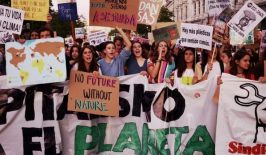Our “global carbon budget” is the estimate of how much CO2 humanity can release into the atmosphere and still be able to keep global warming under safe levels. A new website has turned that budget into a set of clear and comprehensible graphs that can be shared, distributed and used as a persuasive tool for political action – making it as easy as possible for the general public and the media to hold their governments to account.
In the Paris Climate Agreement adopted in 2016, 194 countries and the European Union agreed to limit global warming to “well below two degrees” and “to make efforts” to keep global warming to a maximum of 1.5 degrees (compared to pre-industrial levels). If we are to ever achieve these goals, we need to drastically reduce our global CO2 emissions – and as quickly as possible. The Intergovernmental Panel on Climate Change (IPCC) has worked out just how large the global CO2 budget is, i.e. how much CO2 humanity is still allowed to emit if it wants to be sure to be able to reach these goals and curb global warming at 1.5 or 1.8 degrees. The website showyourbudgets has turned the world’s rapidly shrinking “CO2 budget” into graphs and charts that show exactly when we need to completely stop emitting CO2, and reduce our carbon emissions to net-zero.
What’s your country’s carbon budget?
The IPCC only calculates a global CO2 budget, but no national CO2 budgets. And even the Paris Climate Convention does not specify how this budget is to be distributed among the individual countries. It only very vaguely argues for “common but differentiated responsibilities” among the countries and agrees that countries with high poverty levels should be given more time to reduce their carbon emissions. These vague agreements offer many countries a convenient loophole, as they do not have any national CO2 budgets that they are required to adhere to.
The people behind the showyourbudgets visuals – climate journalist Christian Mihatsch and a team of collaborators – have divided the global CO2 budget among individual countries according to their share of the world’s population. Taking those national CO2 budgets and the countries’ current emissions, they were then able to calculate how long each country has before it has to achieve net-zero emissions and become carbon neutral. “We follow an obvious approach: every person receives the same share of the global CO2 budget. The budget of a country then corresponds to its share of the world population,” Mihatsch explained in an interview with the German website Klimareporter.
The graphs shows the carbon budgets decreasing in a linear way, in completely straight lines. In practice, however, the budgets can shrink in a completely different way.
All emissions are included in the CO2 budget. These include emissions from the combustion of coal, oil and gas as well as from cement production. In addition, emissions from changes in land use, such as clearing or urbanisation, are also included. Emissions from international aviation and shipping are allocated to individual countries according to their share in the global economy.
Deutschland: Should be carbon neutral by 2026
According to this calculation, the CO2 budget available to Germany is fairly small. “In order to have a 66% chance of curbing global warming at 1.5 degrees, with a steady reduction in emissions, Germany would have to be carbon neutral by the end of 2026. For a 50-percent probability of maintaining the temperature rise at 1.8 degrees, the budget would still last until 2046,” says Mihatsch. In the second scenario, however, there is only a 50 percent chance of that 1.8 degrees being maintained. According to several studies, if global warming climbs over 1.5 degrees, our climate system will reach so-called “tipping points”. And once that happens, researchers expect that we will no longer be able to stop global warming – and changes in the climate will be irreversible.
USA: Should be climate neutral by… the end of 2020
According to the calculations done by showyourbudgets, the USA should be climate neutral by the end of this year. Only then will the country keep its emissions on track to limit global warming to 1.5 degrees – which is highly unlikely to happen given the current political situation, and the fact at the time of writing there are only a few months left before the end of 2020. Even raising the acceptable temperature rise to 1.8 degrees compared to pre-industrial levels and reducing the probability of reaching that to 50 percent, the USA would only have twelve years left. “This shows how dramatic the situation has become,” said Mihatsch.
Social inequalities and historical emissions aren’t taken into account
Especially in recent years, there has been increasing attention given to the issue of social justice in the climate movement. One key motivator of the climate justice movement is the idea that the biggest efforts to reduce global CO2 emissions should come from those countries who have been responsible for the largest share of the emissions to date. In other words: industrialised countries in the Western world and former colonial powers that have exploited countries of the Global South and benefited from their natural resources.
However, when calculating the showyourbudgets graphs, the team did not include this aspect – they simply worked out the CO2 budgets of individual countries by looking at their share of the world population, regardless of historical emissions. Mihatsch is aware of the criticism. The reason for the decision was that if all emissions since the beginning of the industrial revolution were taken into account, industrialised countries would have no budget at all. “This is why countries cannot agree on how to divide the budget. This can rightly be considered unfair, but we were looking for a pragmatic solution,” said Mihatsch.
The results of Mihatsch and his team’s calculations seem grim at first sight. The graphs are stark evidence that our window of opportunity to limit global warming is shrinking rapidly – and for some countries, that window is vanishingly small.
But the graphs also function as powerful visual tools. While the Paris Agreement doesn’t specify individual countries’ responsibilities, these graphs make them clear. And because all of showyourbudget’s graphics are available to share under a Creative Commons licence, that means they’re free to be disseminated, shared, and used as a visual tool to help increase pressure on individual governments, demanding that they do more to reduce emissions – and underlining the urgency of the climate crisis to the politicians and decision makers who have the power to stop it.This a translation of an original article that first appeared on RESET’s German-language site.








